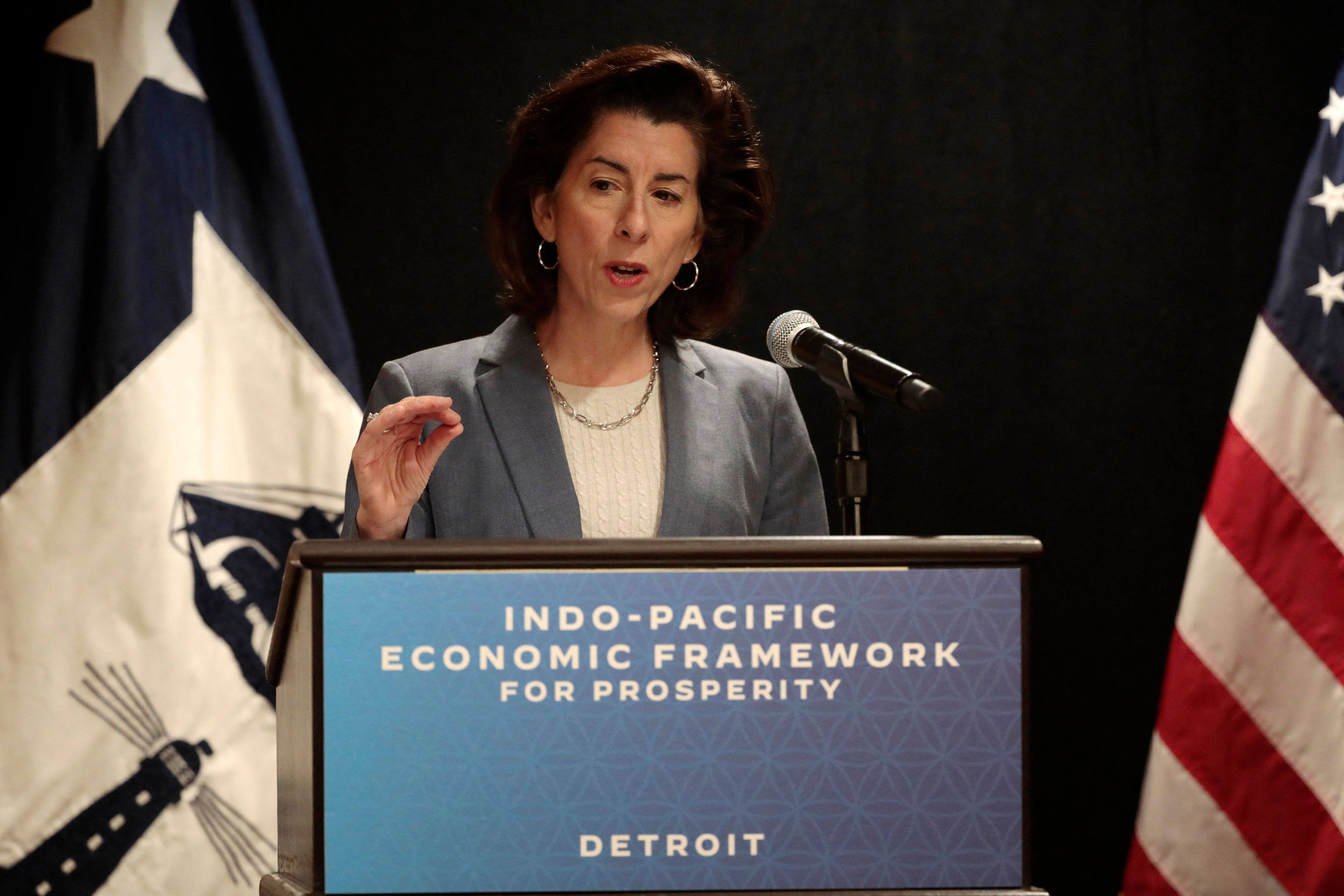As China Tensions Bubble, a New Economic Weapon of Choice Has Emerged
U.S. Commerce Secretary Gina Raimondo and Chinese Vice Premier He Lifeng pose for photographs before a meeting in Beijing on Aug. 29, 2023. Export controls have been a focus of Raimondo’s trip.
Andy Wong/POOL/Getty ImagesAbout the authors: Daniel Silverberg and Elena McGovern co-lead the national security practice of Capstone, LLC, a policy analysis firm.
U.S. Commerce Secretary Gina Raimondo’s trip to China this week underscores an important shift in how Washington is engaging with the world. After decades of U.S. policy aimed at ensuring open market access, “de-risking” the U.S. economy from China has become the animating principle of Congress and the White House. The U.S. government’s economic tools of coercion are evolving to effect this outcome, from a historic reliance on sanctions to a new economic weapon of choice: export controls.
- Export controls were traditionally important mainly to providers of defense components that were deemed “dual use,” or valuable for both civilian and military applications.
- Now, export controls will impact a vast new set of companies. Businesses will need to overhaul their Washington engagement strategies to navigate this new dynamic.
Sanctions were the go-to response to all foreign policy challenges ever since the George W. Bush and Obama administrations’ pioneering use of secondary sanctions on Iran and North Korea. Those types of sanctions allowed the U.S. to influence not just its adversaries but also third parties that might want to do business with them. Along the way, sanctions have been frequently criticized as an overused, perhaps tired element of U.S. power.
_____________________________________________________________________
Opinion | US efforts to rally friends with 'shared values' against China could backfire | South China Morning Post
_____________________________________________________________________
But the debate about sanctions has grown outdated. The focus in Congress and the White House is rapidly shifting from sanctions to export controls. Highlighted by the Biden administration’s new executive order establishing a first-of-its-kind set of U.S. outbound investment restrictions, exports controls are fast becoming the marquis foreign policy tool to deter adversaries and punish bad actors.
- The shift to export controls comes amid an explosion of concern about U.S. dual-use technology flowing to China that could improve Chinese military programs or be used to commit human rights abuses.
- The Trump and Biden administrations restricted export of advanced supercomputing chips to thwart Chinese military technological advancement, and both administrations leaned on a previously unheralded tool—the Commerce Department’s Entity list—to restrict export of sensitive technology.
- Once a company is added to the list, U.S. businesses must seek a license before exporting to it.
- These administrations have used the Entity List similar to the way previous administrations deployed sanctions: to deny access to core U.S. services and technology and force countries to choose between the U.S. and our adversaries.
The Biden administration brought export controls to center stage in 2022 after Russia invaded Ukraine. It prohibited any U.S. semiconductor components from export into Russian military equipment.
- This action not only impacted Russia directly but forced other countries to look at their own supply chains and assess potential leakage to Russia. A policy critics thought would be insurmountably difficult to implement wound up a key component of the U.S. effort to affect Russia’s behavior.
- And it impacted industries that wouldn’t normally think of their products as potentially useful to support military activities, including manufacturers of household appliances and hearing aids.
We now see a comparable proliferation of measures expanding restrictions from traditional areas like arm sales to sensitive technologies. In early August, the Biden administration announced plans to ban capital flows—not just the technology transfer itself—to China in quantum computing, semiconductors, and AI That marks a significant escalation in the deployment of export controls, and one that enjoys bipartisan support.
Like sanctions, export controls may ultimately be seen as an imperfect foreign policy tool. The Russia export restrictions epitomize the highs and lows of this new regime. Putin’s military has been forced to scramble for basic parts, but, similar to sanctions, the impact of the policy has not been nearly as immediate as one would have hoped, and China has stepped in to fill the gap in some cases. Meanwhile, the burdens of complying with the new policy is putting tremendous costs on businesses.
- In July, China announced restrictions on exports of key components for electric vehicles.
- China’s antitrust authority also blocked a corporate merger involving a U.S. semiconductor company operating in the Chinese market, and it banned the purchase of semiconductor chips from Micron, a U.S. company.
- To the extent export controls are ultimately a form of economic warfare, China has extensive leverage.
Practically, companies will need to reorient Washington engagement strategies. Plans that typically focused on Congress and the White House will now need to encompass previously overlooked offices at the Department of Commerce, such as the Bureau of Industry and Security and the Office of Export Enforcement, which provide policy oversight on outbound investment. The same is true of heretofore unknown entities in the intelligence community, such as the National Counterintelligence and Security Center, which could be a leader in intelligence analysis on supply chain risks. The Biden administration recently nominated the Senate Intelligence Committee’s staff director to lead this agency. That makes sense. The White House likely realized it will need someone sensitive to the politics and policy of China de-risking rather than a traditional intelligence expert.
Guest commentaries like this one are written by authors outside the Barron’s and MarketWatch newsroom. They reflect the perspective and opinions of the authors. Submit commentary proposals and other feedback to ideas@barrons.com.
____________________________________________________________________
Opinion | US efforts to rally friends with 'shared values' against China could backfire | South China Morning Post





No comments:
Post a Comment